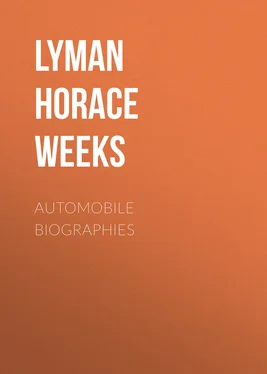Lyman Horace Weeks - Automobile Biographies
Здесь есть возможность читать онлайн «Lyman Horace Weeks - Automobile Biographies» — ознакомительный отрывок электронной книги совершенно бесплатно, а после прочтения отрывка купить полную версию. В некоторых случаях можно слушать аудио, скачать через торрент в формате fb2 и присутствует краткое содержание. Жанр: Биографии и Мемуары, auto_regulations, foreign_antique, на английском языке. Описание произведения, (предисловие) а так же отзывы посетителей доступны на портале библиотеки ЛибКат.
- Название:Automobile Biographies
- Автор:
- Жанр:
- Год:неизвестен
- ISBN:нет данных
- Рейтинг книги:5 / 5. Голосов: 1
-
Избранное:Добавить в избранное
- Отзывы:
-
Ваша оценка:
- 100
- 1
- 2
- 3
- 4
- 5
Automobile Biographies: краткое содержание, описание и аннотация
Предлагаем к чтению аннотацию, описание, краткое содержание или предисловие (зависит от того, что написал сам автор книги «Automobile Biographies»). Если вы не нашли необходимую информацию о книге — напишите в комментариях, мы постараемся отыскать её.
Automobile Biographies — читать онлайн ознакомительный отрывок
Ниже представлен текст книги, разбитый по страницам. Система сохранения места последней прочитанной страницы, позволяет с удобством читать онлайн бесплатно книгу «Automobile Biographies», без необходимости каждый раз заново искать на чём Вы остановились. Поставьте закладку, и сможете в любой момент перейти на страницу, на которой закончили чтение.
Интервал:
Закладка:
Then followed the work on carbureters and ignition devices and details of construction adapting the liquid hydro-carbons of uncertain quality to more satisfactory use. Details became and still are numerous, and optional to a great extent, but the liquid hydro-carbon engine of the compression type distinguished the new epoch. The development of the stationary engine operated with gas from receivers also proceeded rapidly in those days, though it was well into the eighties before the gas engine of the compression type involved a commercially successful industry to any extent; not for several years did the principal manufacturers take up commercially the proposition of the liquid hydrocarbon application. The development of the small engine using liquid hydro-carbons received attention from Marcus, in Austria, and the persistent attention of Benz and of Daimler, in Germany. The two latter, furthermore, adapted their engines to vehicles, and enthusiasm was great when Benz ran his three-wheeler, with explosive engine, through the streets of his native town.
England was still shackled; but in France many were inspired to change from steam to the hydro-carbon engine. About 1890 we find several French manufacturers procuring engines, or the right to manufacture the small explosive engines developed by the Germans, and promptly adapting them to their vehicle construction, already well developed for steam propulsion. Panhard & Levassor; Bouton, with his backer, DeDion; Bollèe, now Leon, the nephew; Delahaye and Peugeot, were among the earliest Frenchmen to appreciate the commercial possibilities of the new type. Then the large manufacturers, already experienced in other lines, and particularly in cycle manufacture, entered the field in 1893, 1894 and 1895; among them such old concerns as DeDetrich, manufacturers for one hundred and more years, grasped the opportunity. America was not idle, and while road conditions in this country militated largely against the early attempts in the industry, the efforts of the Duryeas and of Haynes, and various other experimenters, who have since retired, were heard from. It was difficult, however, with the obstacles then existing in America, for these early workers to secure encouragement, and progress was slow, just as the endeavors of Selden and some of the early steam vehicle people had received nothing but discouragement at the hands of those whom they endeavored to lead to the success of large manufacturing undertakings.
However, the Times-Herald race, in Chicago, near the close of 1895, brought forth a large number of inventors and several starters, including electric, steam and gasoline vehicles, and the showing was such as to practically satisfy the doubting that these were the beginning of the industry in this country.
Abroad, the leaders in the automobile movement organized the now historic races from Paris in different directions. With the runs of 1894, 1895 and 1896, and in each successive year thereafter, and with the road and other conditions improved, the industry rapidly developed. England also was at last reached. The restraints that had existed there for more than half a century could no more be endured. The burden was finally thrown off, for which great credit is due to Sir David Salomon, and the offensive Locomotive Act was at last repealed in August, 1896. The subsequent Locomotive Act which came into effect November 14, 1896, marked a red-letter day in motoring history for England, and was justly celebrated by a procession of vehicles from London to Brighton. Salomon had previously organized an exhibition in England, and had imported a French car, and as a prominent member of scientific and technical societies, in which he presented many papers on the subject, had done, possibly, more than any other individual to influence public sentiment and to secure this new enactment. English manufacturers were not entirely unprepared for the change, and a great wave of interest and activity swept the country. Naturally this was followed by a reaction, but since then a counter-reaction has set in, resulting in the present grand development of that class of manufacturing in the British Isles.
The small steam vehicle of Whitney, and his contemporaries, the Stanleys in the United States, then came to the fore. Under energetic promotion thousands of small vehicles of that type were manufactured and put into use. These, in no small measure, became to the public at large the convincing object lesson of the practicability and possibilities of the small automobile for every-day use.
The Paris show of 1900 revealed a great forward step in the development of constructions, and the offer immediately thereafter of the James Gordon Bennett trophy of international racing gave to the automobile industry such an impetus as has seldom been the good fortune of any other art to receive. To-day the automobile has reached that stage of perfection where the question is no longer whether or not the vehicle will carry you to a certain place and back. Now it is only a question of the speed, absence of vibration, and sweetness of running the engine, absence of all noise, and other details of refinement. Vehicles are now of the Pullman type, luxurious to the extent of prices ranging into the thirties of thousands of dollars, while on the other hand, thousands of small vehicles, costing between five hundred and one thousand dollars, are annually made and sold.
The steam machine, after being practically succeeded by the gasoline, was again improved by the flash boiler. The main development of this new power was carried on by Serpollet, of France, and later, by Rollin T. White, in the United States, both whom have become most able competitors of manufacturers of machines of other classes.
The beginning of 1905 finds us with the annual shows, which have been consecutive for many years, while the census of vehicles now in use, or made in the last ten years, will aggregate several hundred thousand. The annual production is estimated as probably approximating one hundred thousand in a few of the principal countries. The value of the electrical vehicle, particularly as the town vehicle for anything except speeding, is now well established, and reports from Paris as well as New York indicate the lack of facilities of factories in this line for producing these carriages as rapidly as demanded. Heavy ’buses and individual vehicles alike are also popular.
PIONEER INVENTORS
Nicholas Joseph Cugnot,
William Murdock,
Oliver Evans,
William Symington,
Nathan Read,
Richard Trevithick,
David Gordon,
W. H. James,
Goldsworthy Gurney,
Thomas Blanchard,
M. Johnson,
Walter Hancock,
W. T. James,
Francis Maceroni,
Richard Roberts,
J. Scott Russell,
W. H. Church,
Etienne Lenoir,
Amédèe Bollèe,
George B. Selden,
Siegfried Marcus,
Carl Benz,
Gottlieb Daimler,
M. Levassor,
Leon Serpollet.
Born at Void, Lorraine, France, September 25, 1725. Died in Paris, October 2, 1804.
Concerning the early life of Cugnot, little is known. He was educated for the engineering service of the French army, and gained distinction as a military and mechanical engineer. He also served as a military engineer in Germany. Soon afterward he entered the service of Prince Charles of Lorraine, and for a time resided at Brussels, where he gave lessons in the military art. He did not return to his native land until 1763, and then invented a new gun, with which the cavalry were equipped.
Читать дальшеИнтервал:
Закладка:
Похожие книги на «Automobile Biographies»
Представляем Вашему вниманию похожие книги на «Automobile Biographies» списком для выбора. Мы отобрали схожую по названию и смыслу литературу в надежде предоставить читателям больше вариантов отыскать новые, интересные, ещё непрочитанные произведения.
Обсуждение, отзывы о книге «Automobile Biographies» и просто собственные мнения читателей. Оставьте ваши комментарии, напишите, что Вы думаете о произведении, его смысле или главных героях. Укажите что конкретно понравилось, а что нет, и почему Вы так считаете.












